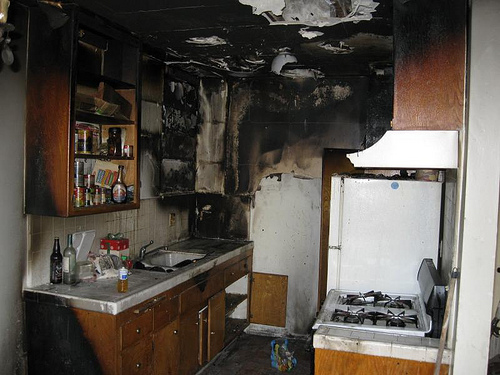We spend a lot of time in our kitchens cooking and eating, but we often don’t realize or remember that the kitchen is the most dangerous room in the house. From sharp knives to hot stoves, there are lots of safety and health concerns to be aware of. Surprisingly, many people don’t know the right things to do in the event of a kitchen injury or emergency, and they fail to follow basic safety procedures to prevent them. Do you know how to be safe in the kitchen? Here are some rules, reminders, and important thing to consider if you don’t already.

The Stove
Whether your stove is gas or electric, it poses the same safety hazards: burns and fires. You know not to touch hot burners, allow your kids to touch the stove, and make sure things that could catch fire aren’t touching or close to the stove. There are some more simple things to keep in mind to prevent burns and fires, and to handle them if they do occur.
Burns
If you burn yourself, quickly put your hand or area of the burn under cold running water. Keeping the burn cold will prevent blisters. Apply ice wrapped in a towel or a bag of frozen vegetables on the burn. If a severe burn occurs, get in the shower under cold water without removing clothing, and seek medical attention as soon as possible. Do not grasp a hot pan or pot with a wet cloth, because you won’t be protected from the heat and will burn.
Fires
If fat or oil gets too hot on the stovetop, it will smoke and then catch fire. In the event of a fat or oil fire, never use water to extinguish it. Throw a damp cloth or a blanket on top and turn off the burner. You can use a fire extinguisher if necessary, but if you can’t control the fire, get out and call the fire department.
Knives
You need to be extra careful with sharp knives, because cuts can happen when you get too careless. Do not leave knives in a drawer, or someone reaching in can cut themselves. In the dishwasher, place them handle-up in the utensil holder rack. Do not leave them in the sink, especially if other dishes get piled on top. The safest place to store sharp knives is in a wooden block or specially-made knife holder. You should also know what to do in case a cut does occur.
Cuts
For most cuts, wash and rinse the cut with cool water. Pat the wound dry, and wrap it with gauze or a bandage. If the cut is deep, apply pressure and raise the cut above your heart. Seek immediate medical attention.
Other Considerations
Make sure that you have a fire extinguisher and first aid kit on hand and within reaching distance of the stove and sink at all times. Make sure every member of your house knows where they’re located. If you have children, be sure to talk to them about kitchen safety so that they’re prepared, too.
Katherine Brown is a cooking guru and mother of 4 who works with Drury Designs. She often writes and blogs about kitchen safety and what to do in the event of a kitchen disaster!
Photo Credit: LAFD

